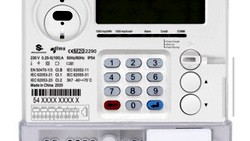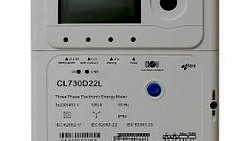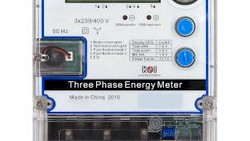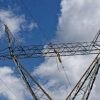Demand is a measure of average power consumption over a fixed time interval. Maximum (or peak) demand is the highest demand recorded over the billing period. The billing period is mostly end of the month.
Non-domestic electrical power users often have to pay a maximum demand charge in addition to the charge for the consumed energy. This additional charge is based on the highest amount of power used over a period (e.g. 15 minutes) during the billing period.
Sometimes the surcharge can also be related to the load-factor.
CLOU meters can operate with a fixed window or with a sliding window. Please note that not all meters have this function.
What is the difference?
The fixed window is defined in certain steps (e.g. 15 minutes), starting at the full hour. It can be programmed for the following fixed intervals:
- 5 minutes
- 15 minutes
- 30 minutes
- 60 minutes
- At the end of each fixed window period, the average power for that period is calculated. If this value is higher than the already existing value, it is stored as the MD (maximum demand).
The sliding window is the CLOU default setting. For sub integration period the default is 1 minute.
At the end of a sub integration period the average power is calculated for one integration period. If this value is higher than the already existing value then this is stored as MD. The integration period slides by a window of the sub integration period.
The maximum demand register MD will be reset at the set transferring time of each month (e.g. 1stof each month). The demand values measured with 6 digits, including 4 integers and 2 decimals.
What is the impact on using different intervals and sub-intervals?
In the example below we are generating a 24 hour load-profile. It's based on values between 30% peak and peak. (1440 samples)
Then we run a evaluation of the MD (maximum demand) for various meter settings. All fixed windows starting at midnight (00:00).
What do we learn?
- The shorter the integration period, the higher the MD value
- The shorter the sub-interval in the integration period, the higher the MD value (except of some strange profile constellations, you might find them)
What are the right settings?
It depends on the purpose for the demand measurement.
If you want to give a penalty to customers exceeding a defined limit, you need to follow the utility rules (e.g. 30 minutes fixed window).
If you are operating with an AMI system, you want to do a load-prediction (forecast) for a period of time. Here it is very common to use a 15 minutes integration time with 1 minute sub-intervals.
| new random load profile | ||
|---|---|---|
| MD Limit | kVA | |
| Peak load | kVA | |
| Integration period 5 minutes | ||
| Integration period 15 minutes | ||
| Integration period 30 minutes | ||
| Integration period 60 minutes | ||
Editor's note: This article was originally published in July 2019 and has been updated for comprehensiveness.





Hello,
If we have maximum demand by current = 39 A in a 1ph meter .it means the meter has a function to calculate the max demand by ampere that equal A= (A1+A2+A3+A4… An) / n which n is the number of samples . so here what is the max demand by KW if the voltage is 220 and PF = 0.7 for example . will it be P= 220 *39*0.7.
Thanks in advance
Thank you for the question. Maximum demand (MD) calculation is based on interval times. Each MD meter has selectable intervals, typically they are set on 15 minutes. So, the meter records the consumed energy for the interval period and then divides the recorded energy by the interval time. The result is the MD for the measured period in kW. If the result is > than the previous one, the MD register is updated with the new result. The MD register will be reset by end of each month after reading. For your example, the MD of the meter will be by End of the month 6.006 kW, assuming that this was the highest recorded MD during all interval periods of the month.
Hello LAOREN,
Thanks for the article.
I know that advanced meters record max demand for Apparent , Active and Reactive Energy and most utilities need to read Active max demand values , so the question here , what is the purpose for recording apparent and reactive energy max demand??
Thanks in advance
Thank you, MAK. Some utilities (very rare) have introduced a reactive demand surcharge. For apparent, I can't recall any example.
Dear sir, I need information from you my total units used 4200 units kwh and 5000 for used kvah how to calculate md. And also we have 58kw power but we have used only 45kw we are pay per kw 150rs/month.so we have reduction our kw below 50kw.its for industrial service.
Maximum demand measurement can only be done by reading the MD register. From your monthly consumption, there is no way to recalculate the MD.
Hello,
I need to read more about the concept of max demand , advise me to some sources.
Thanks in advance.
Thank you for your question. It's hard to find functional explanations about maximum demand, thus why we made this article. Maybe some other meter manufacturers are doing the same, but I don't have references.
Hello
Thanks for the article.
I have a question.
How do meters calculate the maximum demand by Ampere in three phase meters.
For an example :
If
Va =220, Vb =220,Vc=0
Ia=95, Ib=95,Ic=0
The max demand by KW will be 41800 watt.
But what is the max demand by Ampere in this example.
Thanks in advance.
Thank you for your question, Mahmoud. Maximum demand is always expressed as power. This power is recalculated from the consumed energy over a time period. Typical maximum demand periods are 15 minutes or 30 minutes. During these periods you have voltage fluctuations, different currents and different power factors.
Less expensive energy meters will give you only the maximum demand value. Advanced meters have different registers to record the minimum-, average- and maximum values for voltages, currents, phase angles and frequency during the period.
Hi sir, if i want to see % error of the maximum demand using test bench, so what need to do? let say for example, V=230V, I=20A. i need to set the integration time and sliding?
It depends on how comfortable your test-bench is. The procedure is the same as for a register test. You read the maximum demand register of your meter. If the meter was already used, reset the register first. Then you inject with your test bench 230 V and 20 A for your meter integration period (usually 15 minutes). Once finished, you read the demand register again and compare with the power indicated at the reference standard.

If your reference standard shows only the energy, you divide this value by the integration period.
Now you use the common error calculation formula.
Theoretical value is your reference standard reading, experimental value is your meter reading.
Modern test benches can do this automatically. I suggest, you check with your manufacturers operation manual as well.
So far I thought that MD is the peak or max instantaneous KVA which we draw from the system for the specified time period.
But is it the average KVA value over a time period??
It's always the average power for the selected interval time (integration period). The shorter the time interval, the higher is the MD for the same load profile.
Sir i have doubt that the meter is taking
the value of KVA at 5 min or value obtained at 5min is integration of 1s value.
The meter itself has a fixed integration time for energy recording. It's typically 500 ms. This energy is incremented for the selected time period (in your case 5 minutes) and divided by the time period. Then we have the power (kVA) for this period.
What is the MDB for domestic? and is it different to Business?
The maximum demand measurement is mainly implemented for big consumers. It's helpful for utilities to avoid big peaks by giving a penalty for exceeding given limits. Now you can find many domestic meters in the market with this feature but it's rarely used for home.
Nevertheless, together with an AMI system the retrieved data are helpful for planning of power generation.
I need more information on maximum demand meter calculations
If our post is not clear, please ask a specific question.